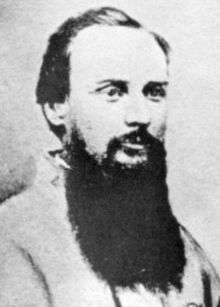Samuel W. Ferguson
Brigadier-General Samuel Wragg Ferguson (November 3, 1834 – February 3, 1917) was a senior officer of the Confederate States Army who commanded cavalry in the Western Theater of the American Civil War. After the American Civil War, he also served as a member of the Mississippi River Commission.[1]
Samuel W. Ferguson | |
|---|---|
 Ferguson in uniform, ca. 1862 | |
| Birth name | Samuel Wragg Ferguson |
| Born | November 3, 1834 Charleston, South Carolina |
| Died | February 3, 1917 (aged 82) Jackson, Mississippi |
| Buried | Greenwood Cemetery, (32°18′29.5″N 90°11′02.3″W)Jackson, Mississippi |
| Allegiance | |
| Service/ | |
| Years of service |
|
| Rank |
|
| Commands held |
|
| Battles/wars | Utah Expedition American Civil War
|
| Alma mater | United States Military Academy |
| Spouse(s) | |
| Children | 4 |
| Other work | Lawyer, civil engineer, writer |
Early life and education
Samuel Wragg Ferguson was born in Charleston, South Carolina, on November 3, 1834, to James, a planter, and Abby Ann (née Barker) Ferguson. Educated at a private school in Charleston, he entered the United States Military Academy in 1852 and graduated in 1857.[2] Before graduation, he joined Colonel Albert Sidney Johnson's Utah Expedition. He then went to St. Louis to join his regiment. After the expedition, he was assigned to Fort Walla Walla in the Washington Territory, where he stayed from 1859 to 1860. This all changed when he received the results of the 1860 presidential election. Hearing of the election of Abraham Lincoln, he immediately resigned and left for Charleston, South Carolina.[3]
American Civil War
In March 1861, Ferguson was commissioned a captain in the South Carolina militia, afterwards being appointed Lieutenant and aide-de-camp to C.S. Army Brigadier-General P. G. T. Beauregard. He was one of the officers who received the formal surrender of U.S. Army Major Robert Anderson at Fort Sumter, raised the first Confederate States flag, and posted the first guards at Fort Sumter. After the siege, he was sent to present the first Confederate flag struck by enemy shot to the Provisional Congress of the Confederate States.[3] He was a lieutenant-colonel and aide-de-camp to General Beauregard during the Battle of Shiloh. During the Battle of Farmington, he was in the 28th Mississippi Cavalry Regiment. He commanded the unit while defending Vicksburg, and helped stop attacks made by U.S. Major-General William T. Sherman and U.S. Commodore David Porter.
On July 28, 1863, Ferguson was promoted to brigadier-general. He was subsequently recommended for promotion to Major-General, but Joseph Wheeler quickly objected.[4] During Sherman's March to the Sea, Ferguson and his cavalrymen harassed the flank of the United States Army. When Sherman got close to Savannah, Ferguson's men left their horses and covered the Confederate retreat. He was then ordered to Danville, Virginia, but before arriving was ordered to go to Charlotte, North Carolina. From Charlotte he escorted Jefferson Davis into Georgia, where his unit was disbanded.[5]
Later life
After the war Ferguson moved to Greenville, Mississippi, where he practiced law. He married Catherine Sarah Lee, daughter of Henry William and Eleanor Percy Lee who was a cousin of Robert Edward Lee.[5] In 1876, he was appointed as president of the United States Board of Mississippi River Commissioners. He was also secretary and treasurer of the Mississippi Levee Board. In 1894, twenty thousand[6] to forty thousand dollars[7] mysteriously disappeared from the Mississippi Levee Board, of which Ferguson was both secretary and treasurer.[6] Later that year, he suddenly left and moved to his hometown of Charleston where worked as a civil engineer. After staying in Charleston, Ferguson moved to Ecuador. It would be many years before he returned.[6] At the outbreak of the Spanish–American War, he tried to join the war effort but he was turned down.[3] On February 3, 1917, Ferguson died in Jackson, Mississippi, where he is buried at the Greenwood Cemetery along with other famous Confederate generals.[4]
Bibliography
- Personal Memoirs of S. W. Ferguson (1900)
See also
References
- "The Cavalry Reunion". Weekly Democrat-Times. 20 (31). Greenville, Miss. February 18, 1888. p. 1.
- Losson, Christopher T. (2017). "Samuel Wragg Ferguson". Mississippi Encyclopedia. Center for Study of Southern Culture. Retrieved May 19, 2020.
- Kansas State Historical Society's Collections of the Kansas State Historical Society (1912) pg. 303.
- Warner, Ezra J. Generals in Gray: Lives of the Confederate Commanders. Baton Rouge: Louisiana State University Press, 1959, p. 89, ISBN 978-0-8071-0823-9.
- Wyatt-Brown, Betram, The Literary Percys: Family History, Gender & the Southern Imagination (1994) pg. 107.
- Black, Patti Carr and Marion Barnwell, Touring Literary Mississippi (2002) pg. 9–10.
- Wyatt-Brown, Betram, The Literary Percys: Family History, Gender & the Southern Imagination (1994) pg. 46–47.
Further reading
- Eicher, John H., and David J. Eicher, Civil War High Commands. Stanford: Stanford University Press, 2001. ISBN 978-0-8047-3641-1.
- Sifakis, Stewart. Who Was Who in the Civil War. New York: Facts On File, 1988. ISBN 978-0-8160-1055-4.
External links
| Wikimedia Commons has media related to Samuel W. Ferguson. |
- Official
- Heyward and Ferguson Family Papers at the College of Charleston
- Heyward and Ferguson Family Papers at the University of North Carolina at Chapel Hill
- Samuel Wragg Ferguson Papers at the Louisiana State University
- General information
- Samuel W. Ferguson at Find a Grave
- Works by or about Samuel W. Ferguson in libraries (WorldCat catalog)